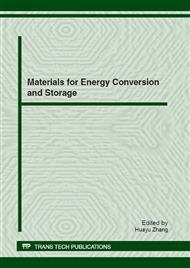p.228
p.232
p.236
p.240
p.244
p.248
p.252
p.256
p.261
Effects of Zinc Cations Doping and the Photo-Absorbed Mechanism for NaTaO3 Nanoparticles
Abstract:
Effects of zinc cations doping into wide band gap semiconductor photocatalysts of electronic structure, visible light response, and photo-absorbed mechanism were studied. A series of Zn-doped NaTaO3 catalysts were prepared by hydrothermal method. XRD results suggested that zinc were successfully doped into the NaTaO3 nanocrystal in the Zn2+ ions state. UV-vis diffuse reflectance spectra indicated no obvious red-shift was observed in the series of zinc doped NaTaO3 photo-catalysts. The simulation of energy band structure by density functional theory unfolded that d orbital of Zn2+ is lower than the Ta 5d and also O 2p orbital, thus it located at the lower energy region of the valence band. Therefore the substitution of Ta5+ ions by Zn2+ ions can not form an intermediate band (IB) between the top of the valence band (VB) and the bottom of conduct band. Meanwhile Zn species can become the recombination centers of photoinduced electrons and holes. Thus, the quickly recombination of e--h+ pairs is one of the most significant factors which deteriorate the photoactivity of Zn-doped NaTaO3
Info:
Periodical:
Pages:
244-247
Citation:
Online since:
July 2012
Authors:
Price:
Сopyright:
© 2012 Trans Tech Publications Ltd. All Rights Reserved
Share:
Citation:


